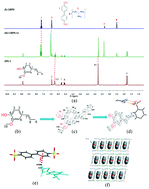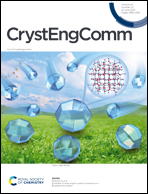Hybrid interaction network of guanidinium–biphenyldisulfonic acid for the structure determination of liquid molecules†
Abstract
Guanidinium–biphenyldisulfonic acid (GBPS) was used as a coformer for the co-crystallization of liquid compounds 1–8 [isoeugenol (1), (−)-isopulegeol (2), eugenol acetate (3), trans-anethole (4), p-anisaldehyde (5), methyl isoeugenol (6), 2,6-dimethylaniline (7), and (1R)-(−)-menthyl acetate) (8)], and their structures were determined by single crystal X-ray diffraction. These liquid compounds were found to be caught in the cavity or channels of GBPS through hybrid interactions including C–H⋯O and C–H⋯N hydrogen bonds, or π–π and C–H⋯π interactions. Hybrid interactions of the guanidinium–biphenyldisulfonic acid network can be regarded as a useful tool for the structural determination of liquid molecules. Guest molecules containing benzene rings are more likely to form π–π interactions with benzene rings in the apohost and enter the cavity. Furthermore, correct absolute configurations of 2 and 8 can be assigned based on the small Flack parameters.



 Please wait while we load your content...
Please wait while we load your content...